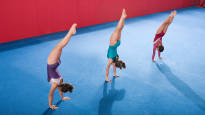The gymnastics association shocked small clubs in particular when it announced its intention to change the teams’ competition fees to personal fees. Today, the teams pay 160 euros per competition. According to the reform promoted by the gymnastics association, every gymnast would pay a fee of a few tens of euros per person in every competition. This would even triple the season’s competition expenses for some teams. The change would affect the gymnastics team sports, team gymnastics, dance gymnastics and team gym, which have previously paid a team fee, the most.
A good example is the fifteen-person team gymnastics group of the Tikkakoski Sports and Fitness Club, which competes in the hobby series for 12-14-year-olds. At this moment, the team pays a participation fee of 160 euros per competition. From the beginning of next September, the fee would be 450 euros per competition, when everyone would pay a per-person competition fee. When a team participates in four competition events in a season, there is an increase of almost 1200 euros.
The increase would hit small clubs outside the capital region the most, which do not have the resources to organize the competitions themselves. Travel, accommodation, food costs and other expenses increase the total expenses to a large extent. According to the clubs, the reform would be in conflict with the Norwegian Gymnastics Federation’s children’s gymnastics policy and responsibility program.
– In small clubs, competitions are a way to become visible and participate. This work also brings equality in that we also exist and children from our area also have the opportunity to go and experience, Hanna Korhonenthe gymnast’s mother and coach from the Tikkakoski Gymnastics and Sports Club says.
– In an adult team of 17 gymnasts, competition fees may be increased by up to 300 percent. The direction is not good if you want to raise children and young people in the world of team sports and enable competition. For some, it can stick to money, company employee Mirka Jussila Mikkelin Gymnasts commented.
Having started as president of the gymnastics association at the beginning of January Mira Keränen according to which the union has aimed for financial equality. Various fees have been reformed over the years. Now it was the turn of the competition fees.
– The costs of organizing the competitions have risen and the wishes of the clubs are being taken into account, specifically that organizing the competitions would also be profitable, Keränen states.
Small clubs forgotten
The change in competition fees made small clubs think about the wider implications of the matter. In the provinces, many clubs feel that they are left alone, outside of decision-making.
– Small clubs have really limited opportunities to organize competitions. We don’t have conditions or halls where competitions could be held. Not enough people in Talkooveke, vice-president of Kalajoki Gymnasts Mirva Mäkelä comment.
– There is pressure from the cities that children’s movement must be affordable and everyone must have the opportunity to participate and have experiences. Such a reform does not steer in that direction. The level of the teams in the capital region is high, but we are afraid that the competitive activity will end here in the north.
According to Mirka Jussila, the experience of inequality is a real problem in the provinces. It is felt that the competition costs of individual sports are also paid by the teams.
– Decision-making has become focused on the capital region. We are forgotten elsewhere in Finland, or at least our point of view is not taken into account, Jussila comments.
– Equality is not about oppressing others. It would be good to solve why competing in some sports is so expensive and try to get the costs down.
Small clubs are often run by volunteers, even without a paid employee. Raising and motivating our own gymnasts to join the team is vital.
– The plight of small clubs is unknown. The fact that competition means a lot more to us. We have active coaches who are being trained. We have active parents who take part in club work. It is vital for a small company to ignite a spark and see the future, Hanna Korhonen says.
Criticism woke up the government
The clubs reacted quickly and gave concrete feedback to the Gymnastics Association. It paid off, because the government withdrew the decision.
– Now the model is being corrected when we recognized that the goal will not be reached. We also extensively involve our trust groups in the future handling of this, says Mira Keränen.
– This is a good process for us to look at how things are prepared for the government, how the field is widely involved in the preparation phase and how trust groups are involved in the preparation.
A new proposal on race fees is being prepared for the board meeting, which will be held at the end of February. According to the chairman, the preparation will be continued until the result is good in the opinion of as many people as possible.
– The union should understand that the clubs are very different and operate in different conditions. The most important things are the development and versatility of the sport, Mirva Mäkelä comments.
– I hope that the Gymnastics Federation would also see the value of small clubs in this country, says Hanna Korhonen.
